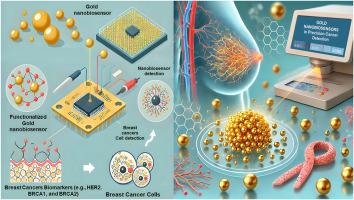Gold nanobiosensors and Machine Learning: Pioneering breakthroughs in precision breast cancer detection
European Journal of Medicinal Chemistry Reports
Pub Date : 2024-10-30
DOI:10.1016/j.ejmcr.2024.100238
引用次数: 0
Abstract
Breast cancer is still one of the major health concerns of today's world. In light of such a scenario, regular improvement in the detection technique is crucial to meet better early diagnosis and treatment outcomes. This present work places much emphasis on gold nanobiosensors, which might be of utmost use in improving breast cancer diagnosis by the excellent sensitivity and specificity they offer for the identification of cancer-related biomarkers. These sensors take advantage of the unique optical and electric properties that gold nanoparticles have, enabling them to achieve an accurate molecular level of detection. Gold nanobiosensors have been significantly developed through innovations like signal amplification and surface functionalization, integrated with the use of advanced imaging techniques. Efforts have been done to enhance their biocompatibility, stability, and scalability for clinical applications. The integration of gold nanobiosensors with emerging technologies, including microfluidics and machine learning, opens new perspectives for personalized diagnostics and point-of-care testing in resource-constrained settings. However, further challenges lie ahead: to enhance manufacturing techniques, to conduct large-scale clinical trials, and to overcome limitations in regulations before widespread clinical applications. Continuous studies and technological advances indicate that gold nanobiosensors have the potential to significantly improve early diagnosis of breast cancer, reducing mortality rates and enhancing the care of patients.

金纳米生物传感器和机器学习:乳腺癌精准检测的开创性突破
乳腺癌仍然是当今世界的主要健康问题之一。有鉴于此,定期改进检测技术对于实现更好的早期诊断和治疗效果至关重要。本研究的重点是金纳米生物传感器,这种传感器具有极高的灵敏度和特异性,可用于识别与癌症相关的生物标志物,从而在改善乳腺癌诊断方面发挥重要作用。这些传感器利用金纳米粒子所具有的独特光学和电学特性,实现了精确的分子水平检测。通过信号放大和表面功能化等创新技术,并结合使用先进的成像技术,金纳米生物传感器得到了长足的发展。人们一直在努力提高它们的生物相容性、稳定性和临床应用的可扩展性。金纳米生物传感器与微流控技术和机器学习等新兴技术的结合,为资源有限环境下的个性化诊断和护理点检测开辟了新的前景。然而,未来还有更多的挑战:提高制造技术、开展大规模临床试验,以及在广泛临床应用之前克服法规限制。不断的研究和技术进步表明,金纳米生物传感器有可能显著改善乳腺癌的早期诊断,降低死亡率并加强对患者的护理。
本文章由计算机程序翻译,如有差异,请以英文原文为准。
求助全文
约1分钟内获得全文
求助全文

 求助内容:
求助内容: 应助结果提醒方式:
应助结果提醒方式:


